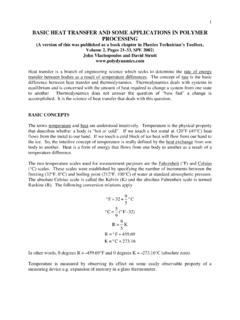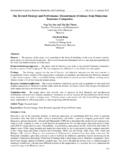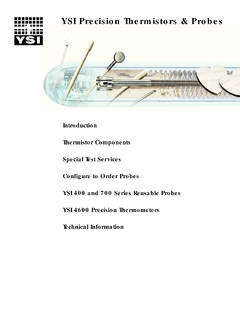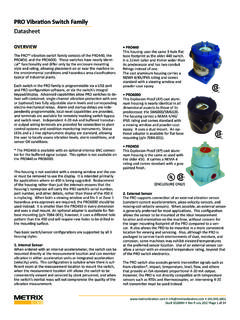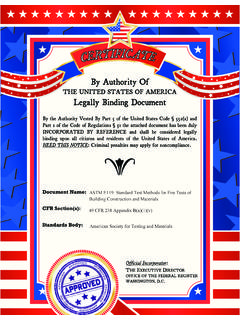Transcription of The Role of Rheology in Polymer Extrusion
1 1 The Role of Rheology in Polymer Extrusion John Vlachopoulos Department of Chemical Engineering McMaster University Hamilton, Ontario, Canada E-mail: David Strutt Polydynamics, Inc. Hamilton, Ontario, Canada Rheology Rheology is the science of deformation and flow of materials [1]. The Society of Rheology 's Greek motto "Panta Rei" translates as "All things flow." Actually, all materials do flow, given sufficient time. What makes polymeric materials interesting in this context is the fact that their time constants for flow are of the same order of magnitude as their processing times for Extrusion , injection molding and blow molding.
2 In very short processing times, the Polymer may behave as a solid, while in long processing times the material may behave as a fluid. This dual nature (fluid-solid) is referred to as viscoelastic behavior. Viscosity and Melt Flow Index Viscosity is the most important flow property. It represents the resistance to flow. Strictly speaking, it is the resistance to shearing, , flow of imaginary slices of a fluid like the motion of a deck of cards. Referring to Figure , we can define viscosity as the ratio of the imposed shear stress (force F, applied tangentially, divided by the area A), and the shear rate (velocity V, divided by the gap h) = h / VA / F = RATE SHEARSTRESS SHEAR = ( ) The Greek letters (tau) and (gamma dot) are conventionally used to designate the shear stress and shear rate, respectively.
3 For flow through a round tube or between two flat plates, the shear stress varies linearly from zero along the central axis to a maximum value along the wall. The shear rate varies nonlinearly from zero along the central axis to a maximum along the wall. The velocity profile is quasi-parabolic with a maximum at the plane of symmetry and zero at the wall as shown in Figure , for flow between two flat plates. 2 Figure Simple shear flow. Figure Velocity, shear rate and shear stress profiles for flow between two flat plates. 3 The viscosity in SI is reported in units of Pa s (Pascal second).
4 Before the introduction of SI, poise was the most frequently used unit (1 Pa s = 10 poise). Here are some other useful conversion factors. 1 Pa s = 10-4 lbf s/in2 = lbm/s ft = 10-2 lbf s/ft2 The viscosity of water is 10 3 Pa s while the viscosity of most Polymer melts under Extrusion conditions may vary from 102 Pa s to 105 Pa s. The shear stress is measured in units of Pa = (N/m2) or psi (pounds (lbf) per square inch) and the shear rate in reciprocal seconds (s 1). One remarkable property of polymeric liquids is their shear-thinning behavior (also known as pseudo-plastic behavior).
5 If we increase the rate of shearing ( , extrude faster through a die), the viscosity becomes smaller, as shown in Figure This reduction of viscosity is due to molecular alignments and disentanglements of the long Polymer chains. As one author said in a recent article: "polymers love shear." The higher the shear rate, the easier it is to force polymers to flow through dies and process equipment. During single-screw Extrusion , shear rates may reach 200 s 1 in the screw channel near the barrel wall, and much higher between the flight tips and the barrel. At the lip of the die the shear rate can be as high as 1000 s 1.
6 Low shear rate on a die wall implies slow movement of the Polymer melt over the metal surface. Some die designers try to design dies for cast film or blown film operations not having wall shear rates less than, say 10 s 1, to prevent potential hang-ups of the molten material. When the wall shear stress exceeds MPa, sharkskin ( surface mattness) occurs in capillary viscometer measurements using various HDPE grades. At very high shear rates, a flow instability known as melt fracture occurs [2, 3]. Melt Index (MI), Melt Flow Index (MFI), or Melt Flow Rate (MFR) (for polypropylene) refers to the grams per 10 minutes pushed out of a die of prescribed dimensions according to an ASTM Standard [4] under the action of a specified load as shown in Figure For PE (ASTM D-1238) the load is kg and the die dimensions are D = mm and L = 8 mm.
7 The experiment is carried out at 190 C. For the PP, the same load and die dimensions are used, but the experiment is carried out at 230 C. Under the conditions of melt index measurement with a kg load, the wall shear stress can be calculated to be w = 104 Pa (= psi) and the wall shear rate approximately = (1838/ ) MI where is the melt density in kg/m3. Assuming = 766 kg/m3 for a typical PE melt, we get = MI. Low melt index means a high-molecular-weight, highly viscous Polymer . A high melt index means low-molecular-weight, low viscosity Polymer .
8 When the melt index is less than 1, the material is said to have a fractional melt index. Such materials are used for film Extrusion . Most Extrusion PE grades seldom exceed MI = 12; however, for injection molding, MI is usually in the range of 5 100. Viscosity can be measured by either capillary or rotational viscometers. In capillary viscometers, the shear stress is determined from the pressure applied by a piston. The shear rate is determined from the flow rate. 4 Figure Newtonian and shear-thinning viscosity behavior. Figure Schematic of a melt indexer. 5 stressshear L/RP = capw ( ) rateshear apparent R Q 4 = 3a ( ) where Pcap is pressure drop, L is capillary length, R is radius, and Q the volume flow rate.
9 The apparent shear rate corresponds to Newtonian behavior (constant viscosity fluids). A correction is necessary (Rabinowitsch correction) for shear thinning fluids. For the power-law model, the true (Rabinowitsch corrected) shear rate becomes R Q 4 n 41 +n 3 = 3 ( ) This means that for a material with power-law index n = (very common), the relation between apparent and true shear rate is apparenttrue = ( ) When capillaries are relatively short (L/R < 50), the Bagley correction is necessary to account for the excess pressure drop Pe at the capillary entry.
10 The Bagley correction is usually expressed as weB2P n ( ) where nB may vary from 0 to perhaps 20 when polymeric materials are extruded near the critical stress for sharkskin. For a Newtonian fluid the value for nB is The Bagley corrected shear stress becomes n + RL 2P + P = Becapw ( ) To apply the Bagley correction, measurements with at least two capillaries are needed. The shear thinning behavior is frequently expressed by the power-law model 1 -n m = ( ) 6 where m is the consistency and n the power-law exponent. For n = 1, the Newtonian model (constant viscosity) is obtained.
